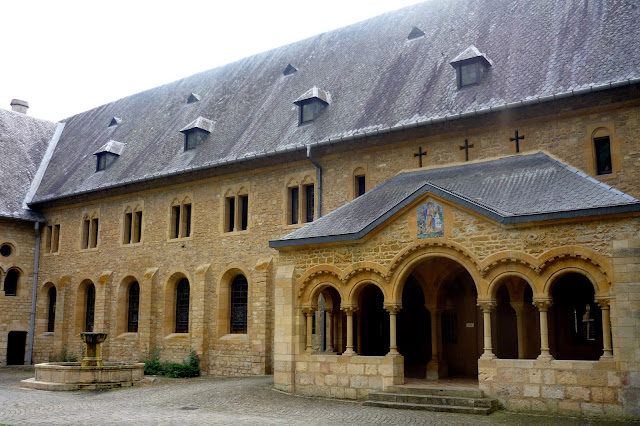May 5, 2017
Each year Waterloo organizes a trip for the seniors of the city. It's always very nice and we visit interesting places. We start early mornings at 7 am, have a coffee/croissant break, and then the visit, lunch and another visit where we usually have free time. This year we visited the Orval Abbey.
In 1070, a group of Benedictine monks from Calabria Italy settled here, and began the construction of a church and a monastery, but after some forty years, they moved away again. They were replaced by a community of Canons Regular, who completed the construction work: the abbey church was consecrated on 30 September 1124.
In 1132, a group of Cistercian monks from Trois-Fontaines Abbey in Champagne arrived, and the two groups formed a single community within the Cistercian Order.
During the 15th and 16th centuries, the various wars between France and various neighbouring regions (Burgundy, Spain) had an important impact on Orval. At one stage a foundry was established on the site. In 1637, during the Thirty Years' War, the abbey was pillaged and burnt by French mercenaries.
In the 17th century, the abbey was converted to the Trappist branch of the Cistercian order, but reverted to the Rule of the main order in around 1785.
In 1793, during the French Revolution, the abbey was completely burnt down by French forces, in retaliation for the hospitality it had provided to Austrian troops, and the community dispersed.
In 1887, the land and ruins were acquired by the Harenne family. They donated the lands to the Cistercian order in 1926. Between 1926 and 1948, the new monastery was constructed, and in 1935 Orval regained the rank of abbey. On 8 September 1948, the new church was consecrated.
The ruins of the medieval buildings remain on the site and are available to view.
Today there are 14 monks living here. The Abbey has a brewery and their beer is very famous. They also produce a special cheese.

The Abbey model we saw in the museum
The following pictures show the Abbey as it stands today
This oak tree is 300 years old
Very nice sculptures stood in the park
From here we could go inside the ruins of the old Abbey
This miniature replica gives you an idea of the whole site
Inside the ruins there are plenty of secret hallways and some we could visit leading to a museum which showed old pieces of tableware, vases etc. Unfortunately the light was not good and I couldn't take pictures.
Inside the abbey
Some parts were well preserved considering the violent past of this old Abbey
This is the new part again
On the other side of the Abbey
The entrance to the church, where the monks held a mass
The church
The entrance or exit
A last glance before going back to the bus
It is a real interesting place I have seen some painters sitting there and paint the Abbey.
For those who want to know more about the abbey here is the link to their Website
Linking to Our World
Tuesday, June 06, 2017
THE ORVAL ABBEYE
Posted by Ingrid at Tuesday, June 06, 2017
travel, vacation, Jordan, Egypt, Spain, Turkey, Orval Abbey, Our World
Subscribe to:
Post Comments (Atom)






























7 comments:
So so old and what a history!
What a lovely place to visit. Did you try the beer or cheese?
Such history Gattina ~ absolutely elegant photos of the Abby and surrounding area ~ ^_^
What an interesting, violent and checkered past this ancient Abbey has. Thanks for explaining it all so clearly. I really enjoyed your post. If you have a chance, pop over to my post; I lost my two horses this weekend and I am shattered!
What a fantastic place!
Sure love the greenry around the place...Coffee is on
What a fascinating place! Someday, I'll make it to Europe to see all the wonderful standing history for myself. Until then, I so enjoy photo tours like this that shows the wonderful architecture that lasts for so long.
Post a Comment